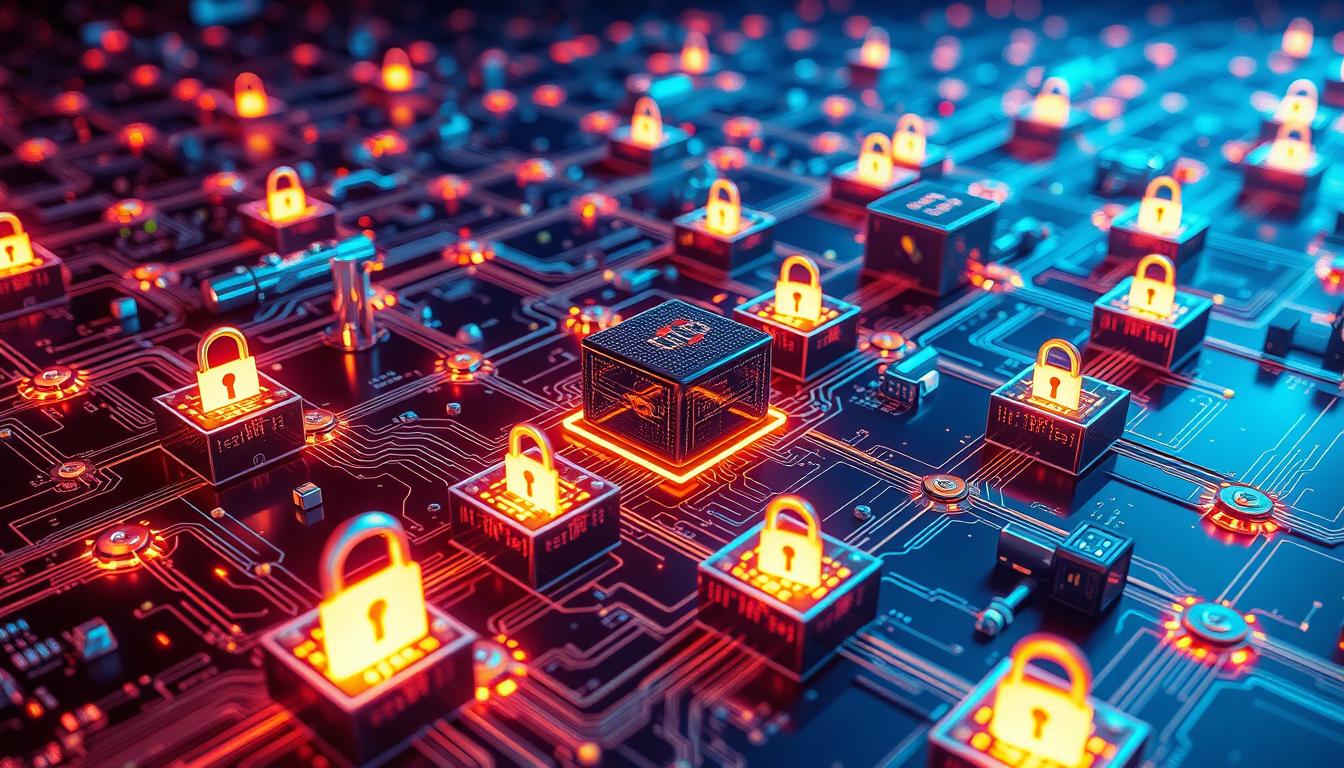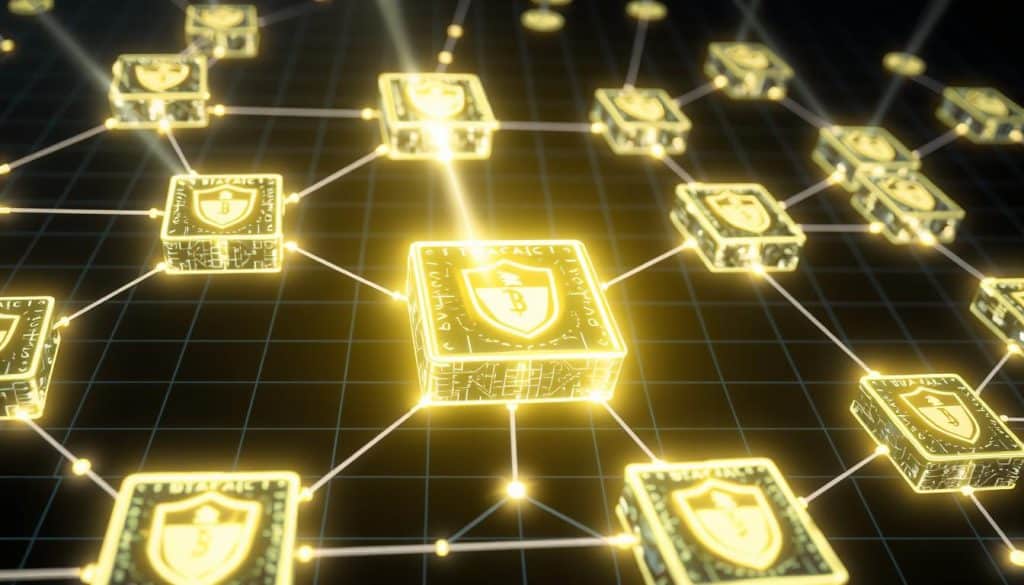Blockchain Security: Discover the Essential Features

The global cryptocurrency market has soared to $3.46 trillion. This growth reveals critical vulnerabilities in blockchain security features. It’s crucial to grasp decentralized consensus and cryptographic hashing1.
Blockchain technology revolutionizes digital security. It changes how we safeguard and handle sensitive information. Blockchain security principles surpass traditional cybersecurity methods2.
This new system resists manipulation and unauthorized access. Digital transactions are becoming more complex. Understanding blockchain security’s core mechanisms is now vital3.
These innovative measures offer unmatched protection. They safeguard digital assets and sensitive data. Cryptographic techniques and decentralized networks are key components.
Key Takeaways
- Blockchain security offers multilayered protection against digital threats
- Decentralized consensus mechanisms enhance network integrity
- Cryptographic hashing provides robust data protection
- Advanced security protocols are critical in cryptocurrency ecosystems
- Understanding blockchain security is essential for digital asset management
Understanding Blockchain Security Features
Blockchain technology has revolutionized digital security with powerful protection mechanisms. It introduces innovative safeguards for decentralized systems. These measures go beyond traditional approaches to secure digital transactions.
Blockchain security is a sophisticated framework for safeguarding digital assets. It relies on critical components to ensure transaction data integrity. This security model uses innovative technological principles for robust protection.
What is Blockchain Security?
Blockchain security protects digital transactions using distributed ledger technology. It offers a comprehensive approach to data protection.
- Immutability of transaction records
- Transparency in network operations
- Cryptographic protection of data
- Decentralized verification processes
Why is Security Important?
Blockchain security’s importance is clear in the growing cryptocurrency markets. Bitcoin hit an all-time high of $108,268.45 on December 17, 20254. This price surge highlights the need for strong security measures.
“Security is not just a feature, it’s the foundation of trust in digital transactions.”
| Security Feature | Key Benefit |
|---|---|
| Distributed Ledger | Eliminates single point of failure |
| Immutability | Prevents unauthorized data modifications |
| Transparency | Enables public verification of transactions |
Countries are expected to implement more regulations for virtual assets4. This comes as global financial landscapes evolve. Mainstream adoption of blockchain technologies requires sophisticated security frameworks.
Blockchain systems build trust through advanced security protocols. They offer unprecedented protection for users worldwide. This reliability is crucial for the future of digital transactions.
Decentralization: A Core Principle
Blockchain technology revolutionizes security through its decentralized approach. It distributes control across multiple network nodes. This creates an unprecedented level of protection against potential vulnerabilities5.
Decentralization is a critical blockchain security feature. It transforms traditional network architectures. Its strength lies in eliminating single points of failure, making blockchain networks incredibly resilient5.
How Decentralization Enhances Security
The power of decentralized consensus emerges through several key mechanisms:
- Distributed network control prevents singular manipulation
- Multiple node verification reduces fraud risks
- Transparent transaction tracking increases accountability
- Collective governance reduces centralized power concentration5
Examples of Decentralized Systems
Real-world blockchain networks show the robust security potential of decentralization:
| Blockchain Platform | Decentralization Strength |
|---|---|
| Bitcoin | Pioneering decentralized financial network |
| Ethereum | Smart contract platform with distributed consensus |
| Solana | High-speed decentralized infrastructure6 |
“Decentralization isn’t just a technology—it’s a paradigm shift in understanding network security.”
Blockchain networks create an intrinsically secure ecosystem by using decentralized principles. This approach challenges traditional centralized models5.
Cryptography: The Backbone of Blockchain
Cryptographic techniques are the foundation of blockchain security. They protect digital transactions and ensure data integrity across decentralized networks. These mathematical algorithms create an impenetrable shield for sensitive information.
Types of Cryptographic Techniques
Blockchain uses multiple cryptographic approaches for security. Key techniques include:
- Symmetric encryption
- Asymmetric encryption
- Hash functions
- Public key cryptography
Understanding Hash Functions
Cryptographic hashing is crucial for blockchain security. These functions create digital fingerprints from input data. They verify data authenticity and prevent tampering.
| Cryptographic Technique | Primary Function | Security Level |
|---|---|---|
| SHA-256 | Data Integrity Verification | High |
| ECDSA | Digital Signature Generation | Very High |
Digital Signatures Explained
Digital signatures authenticate and provide non-repudiation in blockchain transactions. These cryptographic mechanisms ensure that each transaction is genuine, unaltered, and traceable to its original source.
“Cryptography transforms data protection from a hope to a mathematical certainty.” – Blockchain Security Expert
Robust cryptographic hashing and security features make digital transactions transparent and secure. This creates a trustworthy environment for blockchain operations7.
Consensus Mechanisms and Their Role
Blockchain relies on complex consensus mechanisms to maintain network integrity. These systems ensure all participants agree on the blockchain’s state. They prevent unauthorized transactions and keep decentralized consensus8.
Consensus algorithms are the backbone of blockchain security features. They create a robust framework for verifying transactions across distributed networks. These algorithms prevent fraud and keep blockchain ecosystems healthy9.
Overview of Consensus Algorithms
Different consensus mechanisms offer unique approaches to network validation:
- Proof of Work (PoW): Requires computational power to validate transactions
- Proof of Stake (PoS): Relies on token holders staking their cryptocurrency
- Delegated Byzantine Fault Tolerance (dBFT): Allows high-speed transaction processing9
Comparing Proof of Work and Proof of Stake
The two primary consensus mechanisms differ significantly in their approach to network security:
| Mechanism | Transaction Speed | Energy Consumption |
|---|---|---|
| Proof of Work | Slower | High |
| Proof of Stake | Faster | Low |
Impact on Network Security
Consensus mechanisms are vital in protecting blockchain networks from attacks. Decentralized consensus prevents single-entity manipulation of the network. This provides a transparent environment for digital transactions10.
“Consensus mechanisms are the guardians of blockchain integrity, ensuring trust in a trustless system.”
As blockchain evolves, new consensus algorithms will enhance network security. They’ll also improve overall performance of these systems8.
Smart Contracts and Security Concerns
Smart contracts are reshaping how we handle transactions on decentralized platforms. These digital agreements automate processes without middlemen. Blockchain security features are crucial for safeguarding these systems.
Defining Smart Contracts
Smart contracts are self-executing agreements coded into blockchain networks. They use programmable logic to automate complex transactions. Think of them as digital contracts that activate automatically when specific conditions are met.
Potential Security Vulnerabilities
Despite their innovative design, smart contracts can pose significant risks. Key vulnerabilities include:
- Reentrancy attacks that manipulate contract execution
- Integer overflow/underflow problems
- Logic errors in contract programming
- Unauthorized access points
“Security in smart contracts isn’t just a feature – it’s a necessity.” – Blockchain Security Expert
Developers must use strong blockchain security features to prevent exploitation. Thorough testing and code audits are essential.
Advanced encryption techniques help protect digital assets in smart contract systems. These measures ensure the safety of automated transactions11.
Immutable Ledger: Data Integrity
Blockchain technology transforms data management with its distributed ledger capabilities. It creates unmatched trust and transparency in digital record-keeping. The concept of immutability is key to blockchain’s security features.
Understanding Immutable Data Storage
An immutable ledger is a game-changing approach to data preservation. In blockchain systems, recorded information becomes virtually impossible to change or erase.
This feature ensures permanent data integrity and tamper-proof record-keeping. It also provides a transparent transaction history for all users.
- Permanent data integrity
- Tamper-proof record-keeping
- Transparent transaction history
Cryptographic Hashing: The Guardian of Data Integrity
Cryptographic hashing is the main tool for maintaining immutability. Each blockchain block contains a unique hash that links to the previous block.
This creates an unbreakable chain of information. JPMorgan’s Kinexys blockchain processes over $2 billion in daily transactions12, showing its potential.
| Blockchain Security Feature | Immutability Impact |
|---|---|
| Cryptographic Hashing | Prevents unauthorized data modifications |
| Distributed Ledger | Ensures multiple verification points |
| Block Linking | Creates permanent, unalterable record chain |
“Immutability transforms data from a flexible resource to an unbreakable historical record.” – Blockchain Security Expert
Immutability’s power goes beyond financial transactions. Many industries are exploring blockchain’s potential for enhanced security and transparency. Global remittance markets were estimated at $630 billion in 202212.
Privacy Features in Blockchain Security
Blockchain tech brings advanced privacy solutions to the digital world. It balances transparency with user confidentiality across various platforms. Privacy remains crucial in blockchain security.
Blockchain security features are changing how we protect digital info. The main challenge is keeping transparency while guarding individual privacy.
Public vs. Private Blockchains
Different blockchain architectures offer unique privacy approaches:
- Public blockchains provide maximum transparency
- Private blockchains offer enhanced data control
- Hybrid models balance transparency and privacy
Advanced Privacy Techniques
New privacy techniques are changing blockchain security:
- Zero-knowledge proofs enable transaction verification without revealing sensitive details13
- Ring signatures obscure individual transaction origins
- Confidential transactions protect financial data
“Privacy is not about hiding something. It’s about having control over how information is shared.” – Anonymous Blockchain Expert
New blockchain platforms are using complex privacy methods. MyShell shows impressive privacy-focused growth. It has 200,000 AI agents and 170,000 creators helping build secure digital systems13.
The future of blockchain privacy is bright. It aims to create smooth, secure spaces that protect user data. At the same time, it keeps essential transparency.
Regulatory Compliance and Security
Regulatory compliance is now crucial in blockchain security. It requires a strategic approach to navigate complex legal frameworks. This ensures transparency and blockchain scalability.
Understanding Global Regulatory Landscapes
Cryptocurrency exchanges are focusing on strong compliance mechanisms. Coinbase has shown commitment to regulatory standards with over 8 million users. Their approach demonstrates how compliance creates a secure ecosystem.
Key Compliance Strategies
- Implement rigorous Know Your Customer (KYC) procedures
- Develop comprehensive Anti-Money Laundering (AML) protocols
- Maintain transparent transaction tracking
- Engage proactively with regulatory bodies
Importance of Regulatory Adherence
The global crypto market highlights the importance of compliance. Trading volumes spiked by 27%, reaching $162 billion. This growth demands prioritizing security and legal frameworks.
Blockchain projects now see compliance as a path to mainstream adoption. It’s not a burden, but an opportunity for growth.
“Compliance is the bridge between innovative blockchain technology and global financial trust.”
| Compliance Area | Key Considerations |
|---|---|
| Identity Verification | Comprehensive user authentication |
| Transaction Monitoring | Real-time suspicious activity detection |
| Legal Reporting | Transparent communication with authorities |
The future of blockchain security combines tech innovation with regulatory smarts. Embracing compliance builds trust and enhances scalability. It creates robust ecosystems that protect users and investors alike16.
Future Directions in Blockchain Security
Blockchain security is evolving with groundbreaking technologies for enhanced protection and performance. New innovations address scalability and privacy challenges. Blockchain networks are growing rapidly, with wallet accounts expected to reach 5 million by 202510.
Quantum-resistant cryptography is becoming crucial in blockchain security. Researchers are developing advanced encryption to counter potential quantum computing threats. Layer-2 solutions are improving scalability without compromising security14.
Platforms like Shibarium show how Layer-2 tech can cut costs and boost efficiency14. Interoperability protocols enable communication between different blockchain networks. Daily transactions are projected to hit 200 million in 202510.
The future of blockchain security requires robust, adaptable systems. These systems must handle massive transactions while maintaining privacy and protection. AI-driven security measures and smart contract auditing tools are set to transform blockchain security.
The cryptocurrency market is expanding, driving demand for advanced security solutions. Blockchain developers aim to create resilient, transparent, and secure digital ecosystems. These ecosystems will be designed to withstand emerging technological challenges.

